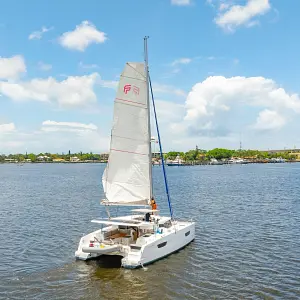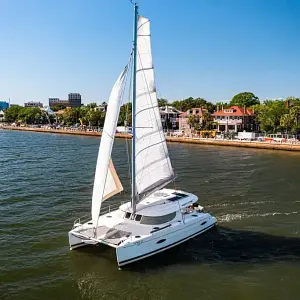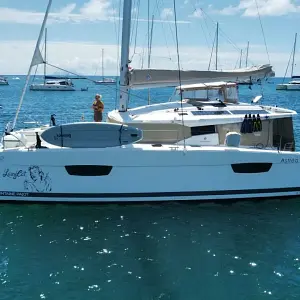BUILDERS REMARKS: The Antigua 37’ is a design from the early ‘90s and features the now tradiotional Fountaine Pajot characteristics. The FP 37’ has a relatively low displacement which makes for lively sailing. Easily handled by a couple.
BROKERS REMARKS: We sold this yacht to the current owner in 2004, and they have finished their blue water adventure. This FP 37’ Antigua is highly recommended and is the priced 37’ Antigua on the market.
BUILDERS REMARKS: The Antigua 37’ is a design from the early ‘90s and features the now tradiotional Fountaine Pajot characteristics. The FP 37’ has a relatively low displacement which makes for lively sailing. Easily handled by a couple.
BROKERS REMARKS: We sold this yacht to the current owner in 2004, and they have finished their blue water adventure. This FP 37’ Antigua is highly recommended and is the priced 37’ Antigua on the market.
She is currently in the southern Caribbean, and is a turn-key yacht, ready for a new owner.
Dimensions
Beam: 21
Displacement: 9900
Engines
Total Power: 19
Tanks
Fuel: 62 Gl`
Fresh Water: 150Gl
Description
- BOAT NAME: Shangri-La
- IS THE NAME TO BE RETAINED: No
- MAKE/MODEL: Antigua 37’
- DESIGNER: M. Joubert / B. Nivelt
- BUILDER: Fountain-Pajot
- WHERE BUILT: France
- YEAR BUILT: 1993
- YEAR/MONTH COMMISSIONED: 1993
- HULL NO (HIN): XXXXX
- REGISTRATION NUMBER: USCG 116XXX
- FLAG: US
- LOA 12m 10 / 37’1
- LWL
- BEAM 6.2m / 19'6
- DRAFT 1.1m / 3’4
- DISPLACEMENT: 9900 lbs./4,900 kg
- KEEL BALLAST: Multihull
Construction
- HULL: Glass Reinforced Plastic (GRP)
- DECK MATERIAL: Textured G.R.P.
- STEERING SYSTEM: Wheel
- DUAL STEERING: No
- RUDDER TYPE: Skeg
- KEEL TYPE: Multihull (can be beached!)
- EPOXY TREATMENT: No
Engine
- NO OF ENGINES: 2
- MAKE/AGE: (2) Yanmar
- MODEL: 2GMF-20
- HP: (2) x 19
- FUEL: Diesel
- NO. OF CYLINDERS: 2 each
- COOLING SYSTEM: Heat exchange
- LAST SERVICED: May 2008
- HOURS RUN/DATE: 3600 port engine/ 2900 starboard engine
- TYPE OF GEAR BOX(S): Sail drives
- TYPE OF CONTROLS: Morse
- DRIVE TO PROP: (2) Yanmar sail drives
- TYPE OF PROP: (2) Two blade fixed prop
- OTHER: Engine temperature alarms
- Emergency engine stops Fresh water cooling system, new freshwater pump starboard engine.
Electrics
- VOLTAGE: 12 V
- NO OF BATTERIES: 3 house & 2 engine
- CAPACITY: 165 Ah house/100 Ah engine
- MAKE: Trojan 6V
- YEAR :2005
- Other: Xantrex Link 20 battery monitor at navigation station
- House/engine batteries may be combined/isolated via Xantrex Pathmaker automatic battery switch port hull and a manual battery switch starboard hull
- METHOD OF CHARGING: Alternator & Wind generator & 12V charger
- ALTERNATORS: (1) Balmar 12V/75A with True charge controller, (1) Hitachi 55 Amp
- Inverter: 1500 watt Cobra Inverter. W/remote panel wired to AC outlets in saloon.
- SHORE POWER: Yes
- CABLE: Yes
Tankage
- NO OF FUEL TANKS: 1
- MATERIAL: Alloy
- CAPACITY OF FUEL TANKS:
- LITRES: 250LGALLONS: 62
- NO OF WATER TANKS: 2
- MATERIAL: Alloy
- CAPACITY OF WATER TANKS:
- LITRES: 600LGALLONS: 150
- HOLDING TANKS: No
Water Systems
- MANUAL Foot pump: No
- PRESSURISED: Fresh water Johnson’ diaphragm type pump. ‘Jabsco’ pressure tank.
- SEA WATER: None
- WATER HEATING SYSTEM: Yes (engine)
Rig
- SPAR MAKER: Z Spar Red Label
- SPAR MATERIAL: Aluminum
- STANDING RIGGING MATERIAL: Stainless steel wire
- LAST REPLACED: Original
- RUNNING RIGGING MATERIAL: Cored braided line
- MAINSAIL REEFING: Slab reefing
- HEADSAIL ROLLER FURLING: Profurl
Sails
- TYPE: Mainsail
- MAKER: D’ Armor France
- TYPE: Genoa
- MAKER: D’ Armor France
- TYPE: Cradle Bag, new in 2007
- TYPE: Genaker
- TYPE: Stormjib 6m2
Winches
- GENOA WINCHES: (2)
- MAKE: Lewmar 44's
- SPEED: 2
- SELF TAILING: Yes
- HALYARD WINCHES: (2)
- MAKE: Lewmar 40's
- SELF TAILING: Yes
Accommodation
- NO OF BERTHS: 10
- DOUBLES: 5
- SINGLES: 0
- NO. OF CABINS: 4
- AFT CABIN: 2
- COOKER TYPE: ENO
- NO OF BURNERS: 3
- OVEN: Yes
- GRILL: BBQ on transom
- FUEL: Propane Trident Gas Control valve and panel.(new in 2005)
- FRIDGE: WACO 12V, 41L capacity, 2006
- SINK: (1) Double basin in galley
- NO. HEADS: (2)
- MAKE: Jabsco new in 2006
- HANDBASIN: (2)
- SHOWER: (2) plus transom shower
- UPHOLSTERY/COLOUR SCHEME: see pictures
- INTERIOR CONSTRUCTION/WOOD TYPE: Laminated marine ply
- HEADROOM: 6’3
- WHICH LAYOUT VERSION: 4 cabin / 2 head
Ground Tackle
- PRIMARY ANCHOR: Delta 35 Lbs with 140’ of 3/8” and 100’ of rode
- SECONDARY ANCHOR: Brittany 30Lbs with 100’ of 3/8”and 50’ of rode
- WINDLASS: Electric
- MAKE: Lofrans Airon 1000W/12V
- OTHER GROUND TACKLE: None
Navigation Aids
- COMPASS: Plastimo
- AGE: Original equipment
- ECHOSOUNDER:
- AGE: Original
- SPEED: NavMan 5100 wind/speed/depth instruments package w/repeater at Nav station
- AGE: 2005
- LOG: NavMan 5100 wind/speed/depth instruments package w/repeater at Nav station
- AGE: 2005
- WIND: NavMan 5100 wind/speed/depth instruments package w/repeater at Nav station
- AGE: 2005
- VHF: ICOM 502 VHF Radio, wired to GPS antenna for distress call w/coordinates
- AGE: 2007
- GPS: GPS unit MLR Electronique Valsat 02L
- GPS antenna wired to a NMEA serial port interface for laptop PC.
- AUTO PILOT: Autohelm ST3000 wheel mount auto pilot
General Equipment
- GAS DETECTOR: Yes
- SEARCHLIGHT: Yes
- HORN: None
- FIRE FIGHTING EQUIPMENT: Yes
- BILGE PUMPS: Electric
- SAFETY EQUIPMENT: Yes
- NAVIGATION LIGHTS: Yes
- GUARDWIRES/PULPIT/PUSHPIT: Yes
- SPRAYHOOD/DODGERS: No
- SUN AWNING/TONNEAU: Yes
- RADIO/ CD: Kenwood AM/FM/CD/MP3 stereo system w/AUX input and external speaker hookup.
- Cerwin Vega 6”x9” speakers in saloon.
- DAVITS: Yes
- SWIMMING LADDER: Yes
- BIMINI: Yes
- DINGHY: No
- OUTBOARD: No
- WARPS: (4) Yes
- FENDERS: (4) Yes
- BOATHOOK: (1) Yes
- Lifelines: Yes
- ENGINE SPARES: Yes
- CUTLERY / CROCKERY / UTENSILS: No
- LIFERAFT: None
- CLOCK / BAROMETER: No
- WIND GENERATOR: Eclectic Energy D400 w/charge controller
- Teak gangway over trampoline net
Service & Maintenance History
- COMMENTS: (PLEASE INCLUDE ANY HISTORY INFORMATION OF THIS YACHT THAT SHOULD BE DISCLOSED IE. ANY KNOWN GROUNDINGS, ANY ACCIDENTS, COLLISIONS, HURRICANE DAMAGE ETC.)
- No damage from any above mentioned incidents.
- SERVICE AND MAINTENANCE HISTORY
- Rudder bearings and steering linkage new in ’07. New Trampoline in ‘06. Spare parts include: starter motor, Hitachi alternator, new engine freshwater pump, impellers, prop, bilge pump, new engine mounts. New batteries in 2005. New navigation instruments in 2005. 6 coats of Seahawk Tropicote bottom paint in ’07.
- ANY DEFECTS (PLEASE STATE FULL LIST OF DEFECTS KNOWN)
- No defects other than normal wear and tear.Boat has been a liveaboard for the last 3.5 years and maintained by owners. It is in general good shape and ready to continue cruising.
Owners Comments:
When we first started looking for a cruising catamaran we were shocked by how expensive they are and how few had the characteristics that would make them good world cruisers. When we found this boat, it had little equipment and needed TLC, but we liked the basic design. We were confident that it was a solid foundation, and that we could transform her into a safe, comfortable, and fast cruising boat. We have spent the last four years doing just that. At this point we are very happy with the result.
SAILING:
The Antigua 37 is a solid, well designed boat. Her basic design maximizes sailing performance and seaworthiness. We have good sail configurations for all points of sail from very light to very heavy wind. She is respectable upwind, excellent on a broad reach, and really shines off the wind (most trade winds cruising) were she is very comfortable and handles very well at wind speeds from 6-8 knots up to about 40 knots (the max sustained wind that we have seen). Having a spinnaker is big plus and is also very easy to handle (no pole needed, sock for easy raising and lowering, lots of deck space to work).
We've all read claims of fantastic speeds on cats. This is true if the boat is kept very light and is pushed hard. This makes sense when racing, but is more difficult and does not make as much sense while cruising. In general we find that we are a little faster than most cruisers our size, and usually keep up pretty well with cruising monohulls in the 40-50 foot range.
In addition to sailing well, Shangri La handles very well under power. With the twin diesels we have excellent control in anchorages and marinas. They are also very fuel efficient, using between 1/4 and 1/2 gallon an hour (that's total for both engines).
SAFE:
We have redundancy in a number of critical areas so that a failure does not compromise our seaworthiness or ability to continue on to someplace to make repairs. To start with we have two engines, two battery banks, and two main water tanks. We added the wind generator to do most of our charging and as a back up to charging with the diesels. We carry the materials to allow us to make most repairs. We have worked through a number of scenarios and tried to be as prepared as possible.
One factor that I have not seen mentioned anywhere else is the "crew factor". We have four private berths. If we want to take additional crew on for a long passage, it does not overcrowd the boat. With 3 or 4 people available to take watches you can: 1) maintain a 24 hour watch, 2) always have a second person available to help the person on watch, and 3) still get plenty of sleep. It is dangerous to get over-tired when sailing.
We have also set Shangri La up to be safe at anchor. We have what many new cruisers considered to be oversized ground tackle, but most people who have been out for a few years agree that it is appropriate. Not only do we have large anchors and chain for our main rode, but we also have a powerful windlass to handle the heavy gear. When we are at anchor, our primary concern is about the possibility of other boats dragging into us. Once our anchor has been set, we have little fear of dragging.
COMFORT:
Shangri La is comfortable at sea and at anchor. On some of the long passages we have kept daily radio contact with other boats in the area. We often heard from others that they were "getting pounded" or rolling so badly that they were often sea sick. Even though we were often in the same area, it never really seemed that bad. a few guests have gotten sea sick, but it is really rare.
The motion of a catamaran is very different than a monohull. The motion is not as extreme in range but is quicker, and it took us a while to get used to it, especially when sailing in short, choppy seas. On the other hand, I had no problem varnishing our the saloon table (with a full can of varnish) while we were doing 7.5 knots on a broad reach. And when we turn downwind it gets really comfortable. Without side pressure on their sails, monohulls can roll terribly. We don't have that problem.
There are two big advantages at anchor. The first is that we don't roll. Our monohull sailing friends are always discussing "rolly anchorages". This is not a problem for us. We wouldn't have even included it as a big plus, but friends with "tippy" boats have really stressed how nice it is. The second big plus is that we have so much room for hosting partys. We love having people on the boat for a day of sailing, sunset cocktails, or a barbecue. The cockpit is very large and comfortable, there is seating for 6 to 8 at the table in the saloon, and there is always room in the bow net (a favorite place to hang out).
SIMPLICITY:
The basic design is pretty simple. While we have put a lot of effort into transforming her into a well equipped cruising yacht, we have still tried to keep her as simple as possible. In our minds she is more of a "working boat" than a "luxury yacht". When we started cruising we were in awe of fancy boats with lots of gadgets. We thought we wanted some of that "stuff", but later learned that it adds very little to the enjoyment of the trip and can actually be more trouble than it is worth (additional maintenance, stuck in a port waiting for expensive parts when there is a failure).
In addition to being fairly simple, the parts are also often cheaper. Even though Shangri La has the space and speed of a much larger monohull, she still weighs just 12,000 lbs fully loaded. Much of the gear onboard is sized primarily by weight. It is cool to look at the huge rigging and winches on a big, heavy boat, but if there is a failure the repair is much more expensive.
Lin and Larry Pardee advice "go simple, go small, go now." While I don't think that a catamaran was what they had in mind, we actually fit the philosophy pretty well. While the design and construction of the hull is complicated and expensive, the end result is a simple and small (light) boat that can comfortably carry four people around the world safely and comfortably.
TRIED AND TESTED:
When things break we have made every attempt to fix them to be at least as good or usually better than original. We have found that when boats start putting on a lot of miles, they tend to have a lot of things break. This is true in general, and is often even true of new, very expensive boats. It is sometimes actually worse for the owners of fancy new boats because 1) they don't expect to have problems because they just spent all that money for "the best money could buy" and 2) the fancy boats often have expensive gear and cost a bundle to fix. Like many boats, we had a fair number of failures early on, but we could usually fix the problems ourselves or with minimal help and money








